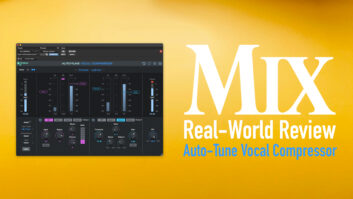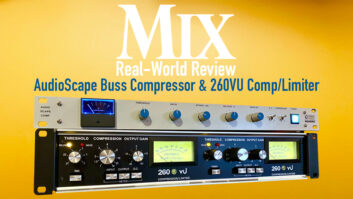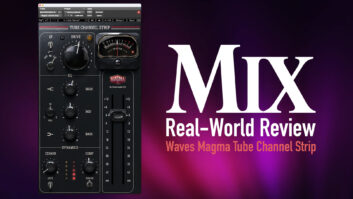
The Chameleon Labs 7802 offers simple controls and a tube stage for adding harmonic color to a track.
Chameleon Labs’ 7802 stereo opto tube compressor offers a feedback design based on a Perkin Elmer VTL5C2 LED/LDR Vactrol gain-changing element. There are two elements per channel: one in the audio path and the other in the meter circuit. A 12AX7 tube gain stage is used for adding harmonic distortion. A fully regulated, linear internal power supply provides all voltages, including high voltage for the tube. Two sets of front panel controls allow dual-mono or stereo-linked operation.
The unit’s attack, release and ratio controls are simplified. Attack and release time settings are folded into a single five-position switch. Attack times are 10/22/32/47/70 ms; release times are program-dependent — about 50/250/400/600/800 ms. The compression ratio is selectable at 2:1 or 4:1 via a toggle switch, while the Compression control sets the squash threshold. A switchable sidechain highpass filter has a 6dB/octave roll-off starting at 90 Hz.
Throughput gain is controlled by Drive and Output. Drive sets the level to the 12AX7; more Drive provides increased saturation and harmonic richness, while Output sets the final level. A green LED shows input signal presence; a red LED indicates input clipping. Each channel also has a small gain-reduction VU meter; there’s no switching available to measure input or output level. Bypass is hard-wired through a relay.
7802 in the Studio
The 7802 has a “hot” feel to it — meaning that ample gain is available. All controls are sensitive, with sonic changes immediately audible. I used it on both live mic sources and tracks already recorded in Pro Tools, and in all cases there was always plenty of gain to get whatever sound I wanted — no matter what input level. Even though the 7802 has a high-tech modern look to its front panel, it worked and sounded like an old-school vintage unit.
When setting up the unit, the Drive control must be turned up before the unit passes any audio. As there’s no way to read input level (and no input level control), using a reference tone from Pro Tools I set the Drive control to about the 9 o’clock position, the Output control at about 2 o’clock and the Compression control fully counterclockwise. I’d like to see the Drive control configured so that the 7802 is at unity when it’s fully counterclockwise with Output at 12 noon. Even with matched VU levels, the Drive at minimum and the Compression control at zero, the signal is warmer and slightly denser after going through the 7802. According to the manufacturer, the THD is dependent on the Drive setting and, assuming a +4 input signal, it will range from 0.1 to 3 percent or more. Distortion is primarily second harmonic, with the third about 20 dB below the second.
On lead vocals, the 7802 sounded and worked much like an old leveling amp, à la Universal Audio’s LA-2 or LA-3. I selected a 4:1 ratio, matched levels carefully and increased the Drive control to about the 10 o’clock position. This causes the vocal to increase in level and “bloom” in size, predominantly in the midrange. This is not an EQ sound; it’s a grainy boost enriched with second-harmonic distortion for a big increase in apparent loudness without too much increase in actual electrical (VU) level. There is no increase of compression when increasing the Drive level.
Strapped across the stereo mix bus, the 7802 will “glue” a mix together. I compared it to my Waves’ SSL stereo-bus compressor plug-in and found I could get a much higher average loudness, albeit with more midrange thickness, depending on where the Drive control was set. If you have trouble with thin-sounding mixes, this is your box. The highpass filter works well for bass-heavy mixes when you want a lot of compression with minimal pumping.
For a synth bass, I preferred the McDSP ML4000 limiter plug-in to the 7802. The Chameleon did warm up the bass, but it didn’t fit the dance pop track as well as the ML4000. In all fairness, I’m comparing apples to oranges: The ML4000 is a multiband peak limiter with look-ahead functionality — a mastering processor.
I had a lot of fun using the Chameleon on a drum loop. I have a faux “When the Levee Breaks” loop, and processing it through the 7802 pushes it into the rock zone hard. If you squash and crank up the Drive control, you can get sounds similar to the loops in Discrete Drums’ Turbulent Filth Monsters library.
Sterile and ultra-clean direct guitars can be “roughed up” through the 7802. I had to crank Drive fully clockwise, but I got more “guts” out of these usually thin and lackluster tracks.
Not Your Average Reptile
By its nature, the 7802 is not the cleanest compressor in my rack, yet it has the most vibe. The Chameleon 7802 sounds like no other compressor out there, and is well-suited to adventure-minded engineers and producers looking to add another color to their sonic palettes.








